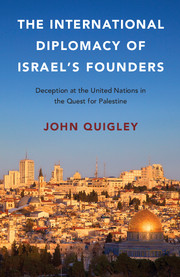 The International Diplomacy of Israel's Founders
The International Diplomacy of Israel's Founders Book contents
- Frontmatter
- Contents
- Preface
- A Note on United Nations Committees
- Abbreviations
- 1 A Public Relations Imperative
- 2 Promises, Promises
- 3 Pranks in Paris and Geneva
- 4 Courting the Commissar
- 5 Saving Europe's Jews – Our Way
- 6 Smoke and Mirrors at the YMCA
- 7 The Ship that Launched a Nation
- 8 Cocktails at the Consulate
- 9 Causing Chaos
- 10 Denying the Undeniable
- 11 A Peace-Loving State?
- 12 Joining the World with Fingers Crossed
- 13 Israel: 1, United Nations: 0
- 14 A Phantom Attack
- 15 Sabras in Sinai: Pardon My French
- 16 Suez Smoke-Screen
- 17 Mr. Nasser, Please Attack
- 18 Abba Eban's Finest Hour
- 19 Old Issues, New Lies
- 20 An Organization Turned Sinister
- 21 Prevarication Pays
- Notes
- Bibliography
- Index
12 - Joining the World with Fingers Crossed
Published online by Cambridge University Press: 05 January 2016
- Frontmatter
- Contents
- Preface
- A Note on United Nations Committees
- Abbreviations
- 1 A Public Relations Imperative
- 2 Promises, Promises
- 3 Pranks in Paris and Geneva
- 4 Courting the Commissar
- 5 Saving Europe's Jews – Our Way
- 6 Smoke and Mirrors at the YMCA
- 7 The Ship that Launched a Nation
- 8 Cocktails at the Consulate
- 9 Causing Chaos
- 10 Denying the Undeniable
- 11 A Peace-Loving State?
- 12 Joining the World with Fingers Crossed
- 13 Israel: 1, United Nations: 0
- 14 A Phantom Attack
- 15 Sabras in Sinai: Pardon My French
- 16 Suez Smoke-Screen
- 17 Mr. Nasser, Please Attack
- 18 Abba Eban's Finest Hour
- 19 Old Issues, New Lies
- 20 An Organization Turned Sinister
- 21 Prevarication Pays
- Notes
- Bibliography
- Index
Summary
In its bid for membership in the United Nations, Israel confronted more objections in the General Assembly than it had faced in the Security Council. The Security Council takes war and peace as its main issue of concern, so Israel’s conclusion of an armistice with Egypt weighed heavily in its favor. The General Assembly takes a broader frame of reference in thinking about the peace-loving character of an applicant state. The issues of repatriation and Jerusalem would figure more heavily in its deliberations. And the General Assembly included all member states of the United Nations, so Israel would fact more delegates who could ask uncomfortable questions.
During the weeks following the Security Council recommendation, Israel did not help itself to show its peace-loving character. Just after the Security Council vote, Israel took more territory in violation of Security Council Resolution 54. The IDF seized an Arab fishing village called Umm Resh Resh at the northern tip of the Gulf of Aqaba. One fishing village may not seem important in the overall picture in Palestine, but this one was special. It sat at the southern tip of the Negev Desert, on the Gulf of Aqaba. Shertok had said that Israel sought “a foothold on the Gulf of Aqaba” as a “gateway to the Eastern seas.” Resolution 181 envisaged this access point to the Gulf of Aqaba as adhering to the prospective Jewish state. By Resolution 54, the Security Council in July 1948 had decided, as we saw, that no more territory should change hands by use of force. Mark Ethridge denounced the action as a violation of Security Council Resolution 54. Umm Resh Resh was renamed Eilat. Israel would open a port facility there in 1952.
Nor did Israel take action on the two hot-button issues – repatriation and Jerusalem – to blunt the objections raised by Britain in the Security Council. During this time, more governmental offices were relocated from Tel Aviv to Jerusalem. No move was made to repatriate the displaced Arabs. On the contrary, the IDF continued to expel Arabs from rural areas of Palestine. During this time, it intimidated several thousand villagers in the northern Negev into fleeing. In the Galilee, it emptied a number of villages.
- Type
- Chapter
- Information
- The International Diplomacy of Israel's FoundersDeception at the United Nations in the Quest for Palestine, pp. 120 - 137Publisher: Cambridge University PressPrint publication year: 2016
